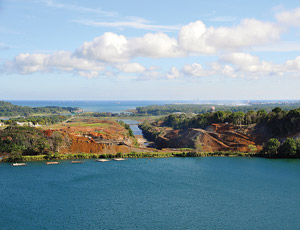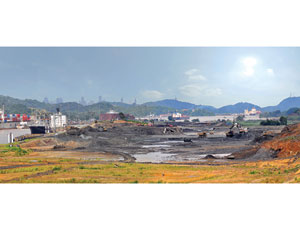Belgian dredging firm Jan de Nul has won the Panama Canal expansion’s last major contract, a $54.5-million job to dredge and excavate 4 million cu meters at the entrance of the historic waterway’s Pacific access channel. The contract will make way for construction of new and larger locks.

The Belgian firm bested two other companies for the contract. International Underground Corp., Jacksonville, Fla., proffered a $55.3-million bid, and a consortium of Central American firms, BKI-Meco, bid $71.3 million. The project, awarded on Sept. 16, will connect the new locks to the canal’s existing navigational channel, located near the Gaillard Cut.
The $5.2-billion Panama Canal Third-Lane Expansion effort is slated for completion in 2014, the waterway’s centennial anniversary. Construction of two sets of massive new locks at either end of the 80-kilometer-long passage will double the canal’s capacity, says the Panama Canal Authority (ACP), the quasi-governmental organization that oversees the waterway and its expansion.
Last year, Jan de Nul won a $89.6-million contract to dredge the Atlantic approach to the canal. It has completed about 10% of the work to remove 14 million cu m of material and has the option to dredge an additional 2.3 million cu m for $16.4 million. The company is also part of Grupo Unidos por el Canal, the Spanish-led consortium that won the $3.1-billion contract to design and build the expansion’s massive new locks.
The new access channel will run roughly parallel to the existing Miguel and Miraflores locks, which are located at either end of the 2.5-km-long Miraflores Lake, but it will be roughly 2 ft higher in elevation. Building the channel involves removal of 48 million cu m of material as well as major tasks, such as rerouting the Cocoli River and construction of a 1.7- km-long clay core dam. ACP says the first three dry excavations are almost complete. Work on the fourth, awarded in December 2009, has just begun.
Construction of the new locks will encompass more than 60% of the expansion effort. Last July, an international construction team led by Spanish contractor Sacyr Vallehermoso SA landed the massive design-build job with a winning bid of $3.1 billion. To date, locks work has focused on initial preparation, but the effort is expected to pick up speed over the next several months.
Grupo Unidos for el Canal is focused on lock construction design and logistics. Canal program manager CH2M Hill Cos., Denver, and ACP have created an integrated management system that includes a representative from each organization at almost every level.
The expansion’s other primary effort so far is dredging for larger “post-Panamax” vessels. Crews must remove more than 50 million cu m of material.
In addition to Jan de Nul’s Atlantic-entrance dredging, another Belgian firm, Dredging International, is doing likewise at the Pacific entrance. The company, which won the $177.5-million contract in 2008, already has excavated half of the estimated 9 million cu m of material there.
ACP is relying on its own dredging fleet, the largest in the hemisphere, to remove 27 million cu m from Gatun Lake and the navigation channel. It has completed about a third of this work. But Dredging International also won a $39.9-million contract this summer to dredge 4.6 million cu m from the lake’s northernmost part, one of the few big dredging jobs within the canal route itself that was contracted to an outside firm.


